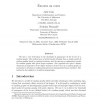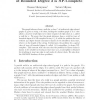70 search results - page 5 / 14 » Degree sequence and supereulerian graphs |
COMBINATORICS
2006
13 years 9 months ago
2006
We give a new derivation of the threshold of appearance of the k-core of a random graph. Our method uses a hybrid model obtained from a simple model of random graphs based on rand...
MFCS
1995
Springer
14 years 1 months ago
1995
Springer
The graph inference from a walk for a class C of undirected edge-colored graphs is, given a string x of colors,
nding the smallest graph G in C that allows a traverse of all edge...
STOC
2000
ACM
14 years 2 months ago
2000
ACM
We propose a random graph model which is a special case of sparse random graphs with given degree sequences. This model involves only a small number of parameters, called logsize ...
ALGORITHMICA
2007
13 years 10 months ago
2007
Two classic “phase transitions” in discrete mathematics are the emergence of a giant component in a random graph as the density of edges increases, and the transition of a rand...
JAIR
1998
13 years 9 months ago
1998
Using an improved backtrack algorithm with sophisticated pruning techniques, we revise previous observations correlating a high frequency of hard to solve Hamiltonian cycle instan...


